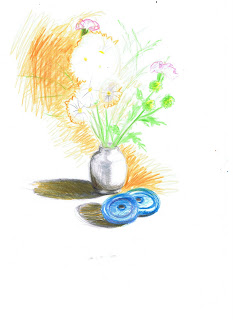Spent a while on this one. My subject was a wolf. Most of the time was spent on quick sketches. This did help a great deal. Over time I looked more and more carefully. The more you look the more you notice.
The final drawing was okay. I think that the linework need to be even looser and more attention should have been paid to negative space. Another fault was the lack of tone and depth. The wolf was white and had lot's of fur (who knew?) - found this difficult to portray in the time that I had.
Research point - 22.02.11
“Look at how Renaissance masters such as Leonardo and Dürer depicted animals. Make notes and try and find some images to include in your learning log.”
Leonardo de Vinci: The great thing about Leonardo work is how often it is done a very loose fashion, using the minimal amount of lines to show the most detail. One thing that comes through from his sketches of animals is how the focus of these drawing is less about texture and more about the anatomy of the creature – in particular the muscles underneath. Still, there is great life in most of them due to the looseness and yet great accuracy of his studies.
Albrecht Dürer: Dürer's work is different to Leonardo's in many respects. Textures; fir, skin, etc, are clearly shown. Many of his sketches are more tight. Strangely, his work seems to swing between highly life like and other times they are heavily stylized (compare the rhino and elephant below, for instance). Yet there is still a great deal of looseness to most of his work that I could find – the tighter, “finished” look of Dürer, suggest that in some of his work he spent more time on his sketches. Those of his drawing that are more loose are actually more life-like. This could suggest that these are sketches of living “specimens” as oppose to the others.
Raphael: It wasn't possible to find examples from all Renaissance masters of depictions of animals. Seeing as most of their work was about people or biblical scenes, even those animals that I could find were in the background. Raphael is a good example of this. In the example on the right, the animals are by no means the subject of the work. However, it still possible that, for Raphael, less is often more when it come to animals.






















